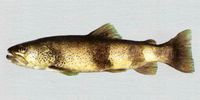Salmo Rhodanensis.
Species description.
Salmo rhodanensis, commonly referred to as the Rhône trout, is a rare and highly localized species of freshwater salmonid that once thrived in the Rhône River basin in southern France and possibly eastward up to the Roia River basin. It is of great interest to scientists and conservationists due to its unique evolutionary lineage, ecological adaptations, and current conservation status.
Taxonomy and Classification.
Salmo rhodanensis belongs to the family Salmonidae, which includes trout, salmon, and chars. It was initially considered a local form of the brown trout (Salmo trutta), but genetic and morphological studies have since revealed that S. rhodanensis represents a distinct taxon. Some researchers classify it as a separate species, while others consider it a unique lineage or subspecies within the Salmo trutta complex.
The debate over its taxonomic status continues, but there is increasing recognition that it constitutes a separate evolutionary unit deserving of specific conservation efforts.
Physical Characteristics.
Salmo rhodanensis shares similarities with Salmo trutta but can be distinguished by several characteristics:
- A generally silvery or greyish body coloration with few or no red spots.
- 4 black bars behind the gill opening.
- A more streamlined shape.
- 9 to 12 elongated parr marks in juveniles.
Adults typically range from 25–50 cm in length, although larger individuals were once common and fish of up to 80cm where found before population declines.
Habitat and Distribution.
Historically, Salmo rhodanensis inhabited the fast-flowing, cold waters of the Rhône River and its tributaries in south-eastern France and possibly the river basins eastward up to the Roia River basin. Its range extended through alpine and subalpine streams, where it adapted to high-oxygen environments and strong currents.
Today, its presence is either severely diminished or possibly extirpated in the wild, with most original populations displaced or genetically diluted due to human activity.
Ecology and Life History.
Salmo rhodanensis was adapted to mountain and foothill streams, feeding on aquatic insects, crustaceans, and small fish. It was likely a spring or autumn spawner, laying eggs in gravel beds in oxygen-rich riffles.
Its life cycle and behaviour were generally similar to those of other trout species, though its adaptations to Rhône basin conditions made it ecologically unique.
Conservation Status and Threats.
Salmo rhodanensis is considered Critically Endangered or possibly Extinct in the Wild. The major threats to the species include:
- Hybridization, with widely introduced Salmo trutta, especially hatchery strains.
- Habitat degradation, from damming, pollution, and water abstraction.
- Loss of genetic integrity, as native populations have been replaced or genetically diluted by non-native trout.
- Climate change, altering the hydrology and temperature of mountain streams
- River pollution, in the last few years populations have lost big numbers of fish due to pollution.
Recent efforts have focused on identifying remnant populations, maintaining captive stocks, and restoring habitats where reintroduction might be feasible.
